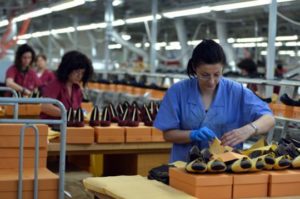The survey conducted by Assocalzaturifici for the first nine months of 2017 on a large sample of businesses belonging to the footwear manufacturing industry outlines a scenario of stability that is characterised, however, by a good dose of caution. Although all the indicators are positive – starting with production, which has grown on average by 0.7% in volume and 2.1% in value – the sector’s timid recovery struggles to get fully underway, especially in light of 2017’s third quarter results, “with volumes more or less unvaried, a slowdown in exports and the domestic demand once again stagnant”.
“We are starting to make progress at the end of a year where, after a long period of unsatisfactory results, the first few timid signals of a market reversal are making themselves known – was the comment of Annarita Pilotti, President of the Association. – However, we cannot allow ourselves to get too excited: the recovery, already recorded in other national sectors of production, has not yet begun for us, although there are reassuring signals arriving from the data recorded for the first nine months of the year, giving us hope that the road we have chosen is the right one. However, many businesses are still in difficulty”. 
As always, the stability of the sector is due above all to exports which, during the first nine months of 2017, rose by 2.2% in value and by 1.4% in quantity (source: ISTAT). The EU’s performance fell short of non-EU markets, with the recovery in Russia taking a sharp upswing (+28.3% in volume and +18.4% in value), while the USA experienced an improvement in its demand (+6% in volume), and a general recovery was registered in the Middle East (+3.2% in quantity). The Far East, instead, experienced a slowdown (-6.8% in volume and -4% in value), since the positive performances recorded in South Korea and China were unable to compensate for the -12% loss experienced in Japan and Hong Kong. Thanks to these dynamics and the simultaneous slowdown in imports (-1.6% in value and -3.3% in quantity), the sector records a favourable trade balance of 2.97 billion euros (+6.8% over the same period in 2016), thus reconfirming the important contribution of the Italian footwear manufacturing industry to the national trade balance.


And in Italy? The brief recovery is filed away, with the domestic demand once again recording extremely weak figures (+0.4% in value and -0.3% in quantity), with the only positive segment represented by sneakers, which is on the rise by 4%.
The briefing of Assocalzaturifici ends with a demographic picture of active businesses and employees: although 99 companies went out of business, employment numbers in the sector went up by an additional 279 employees.




